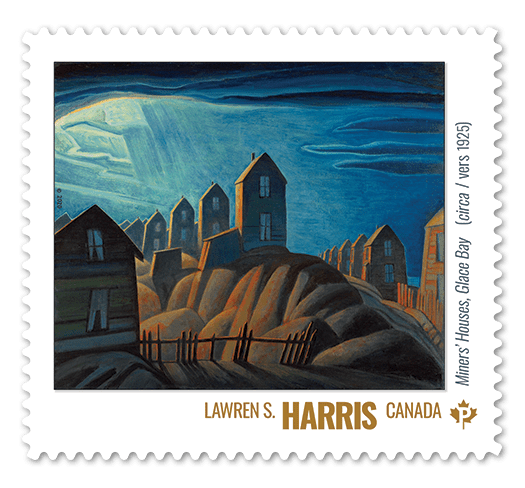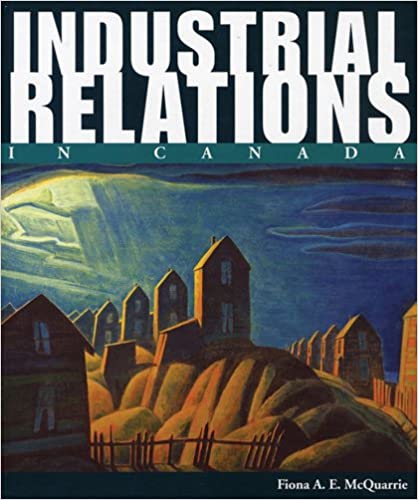
Canada Post has just released a set of stamps celebrating the 100th anniversary of the first exhibition by the Canadian painters who became known as the Group of Seven. The set has one stamp for each of the seven painters, and the stamp for Lawren Harris shows his painting Miners’ Houses, Glace Bay. I was delighted to see that Canada Post chose this painting, not only because it was the cover image of the first edition of the textbook that I write, but because Miners’ Houses represents an important part of Canadian labour relations history.
Harris created the painting in 1925, after a trip to Nova Scotia. The houses at Glace Bay, near Sydney, were the homes of mineworkers and their families; at the time of Harris’ visit, the miners’ union was engaged in a lengthy strike against the mine owners, rebelling against the miners’ poor living and working conditions. Harris was sent to Glace Bay by the Toronto Star newspaper to report on the strike, and he was appalled at what he saw. He painted Miners’ Houses and several other works to draw attention to the strike and to the miners’ plight. The resulting publicity helped the miners’ union achieve its bargaining demands and end the strike, and the conflict between the miners and the mine owners became the impetus for several significant improvements to Canada’s federal labour policies.
The story of how Miners’ Houses became the cover image for my textbook also speaks to the legacy and significance of this painting. When I wrote the first edition of the book, I was a newbie author with zero knowledge of how textbook covers were designed – but since this book was very definitely Canadian, I wanted a Canadian picture on the front. My extremely tolerant editors told me to find some images that I liked, and since the Group of Seven are so widely recognized as iconic Canadian artists, I thought a Group of Seven image would be ideal.
When I started searching for a cover image, I knew I wanted something that was visually interesting and that conveyed “Canadian”, but also reflected the themes in the book. I was first attracted to Miners’ Houses because I liked how it looked, but when I discovered the story of its origins, I knew this image had to be the cover. I had no idea how much that would cost, or who owned the rights to the image, but I wanted it on my book.
Thankfully, my editors agreed, and they set out to get the rights to use the image. The actual painting is in the collection of the Art Gallery of Ontario (AGO), but the reproduction rights are controlled by Harris’ estate. At the time, the estate was administered by Harris’ daughter (who has since passed away). The publisher contacted her and sent her a mock-up of the cover, with an explanation of what the book was about. She was thrilled at the request to use Miners’ Houses on the cover of a Canadian book about labour relations. Not only did she grant permission for its use, but she charged a fee that was a fraction of what the reproduction rights would usually cost. When my editors told me this, I was so overwhelmed that I burst into tears.

There’s another part of the story about the book cover that my editors didn’t tell me until later. To its credit, the AGO is very protective of the works in its collection, and that includes making sure that reproductions of those works are accurate. To be able to use Miners’ Houses, my publishers had to give the AGO final approval of the image as it appeared on the book’s cover. When the book was ready, the finished cover was sent over to the AGO – and literally hours before the book was going to be printed, the cover had to be pulled and redone because the AGO was not satisfied with the colour balance in the painting! I didn’t know about this at the time, and I’m glad I didn’t because I probably would have had a heart attack. But it was reassuring to learn that the AGO is such a good caretaker of its works.
Ironically, with Miners’ Houses being so special to me, I’ve never actually seen the painting in person. I’ve been to the AGO many times, and I’ve seen many of the other Lawren Harris works in its collection, but Miners’ Houses has never been on display when I’ve visited. It’s one of my goals to see it for myself one day – because Miners’ Houses is a beautiful painting that also demonstrates the power of art to make meaningful change in society. I’m very happy that Canada Post has chosen to honour it.
See also: The Economic Gospel of J.B. McLachlan, 1919
Dr. Fiona McQuarrie is an author and Professor in the School of Business at the University of the Fraser Valley
Originally published on Dr. Fiona McQuarrie’s All About Work, an always interesting Canadian blog about current events and issues in the world of work and organizations. Used by permission.
With a special thanks to our generous donors who make publication of the Nova Scotia Advocate possible.
Subscribe to the Nova Scotia Advocate weekly digest and never miss an article again. It’s free!



